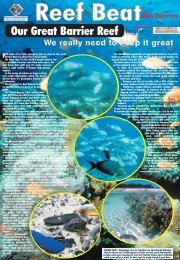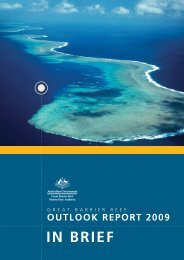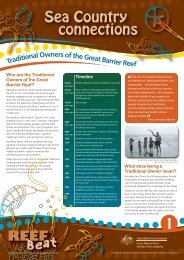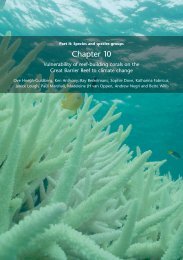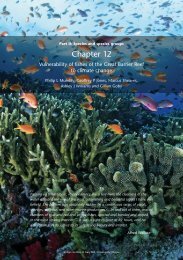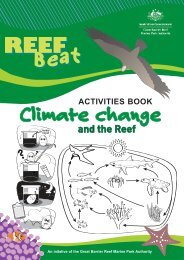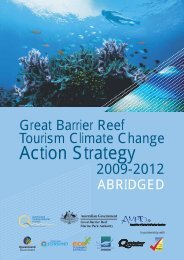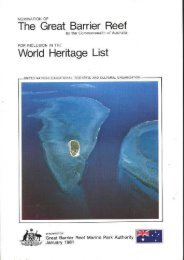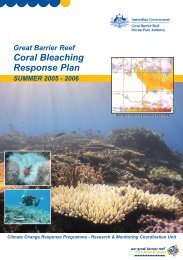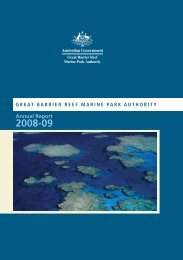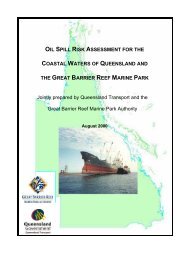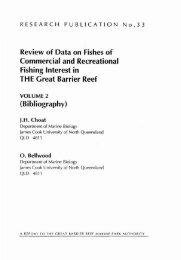2005 Reef Beat posters 1-8 in Cairns Post.pdf - Great Barrier Reef ...
2005 Reef Beat posters 1-8 in Cairns Post.pdf - Great Barrier Reef ...
2005 Reef Beat posters 1-8 in Cairns Post.pdf - Great Barrier Reef ...
- No tags were found...
Create successful ePaper yourself
Turn your PDF publications into a flip-book with our unique Google optimized e-Paper software.
8reef beatriver to reefsomewhere!goes all ItMany daily activities have the potential to upset thedelicate ecological balance of our waterways.When <strong>in</strong> thewater, try not toWhether you live <strong>in</strong> a major city, smalltown or <strong>in</strong> the country, what you doat home, work and school <strong>in</strong> thegraz<strong>in</strong>g and cropp<strong>in</strong>g.To make space for these agriculturalactivities, large areas of native vegetation havestir up sedimentor disturb coral.<strong>Great</strong> <strong>Barrier</strong> <strong>Reef</strong> catchment can affect thebeen cleared. This, along with over-stock<strong>in</strong>g onquality of water <strong>in</strong> the <strong>Reef</strong>.farms, has caused widespread soil erosion <strong>in</strong>Many of your daily activities may <strong>in</strong>crease thelevels of nutrients, sediments and chemicalsbe<strong>in</strong>g discharged to the <strong>Great</strong> <strong>Barrier</strong> <strong>Reef</strong>.FROM THE CITY TO THE SEANutrients, sediments and other pollutants canreach our <strong>Great</strong> <strong>Barrier</strong> <strong>Reef</strong> through a numbersome parts of the <strong>Great</strong> <strong>Barrier</strong> <strong>Reef</strong> Catchment.This has led to the <strong>in</strong>creased dischargeof eroded material such as nutrients andsediments to the <strong>Great</strong> <strong>Barrier</strong> <strong>Reef</strong>.The discharge of these pollutants occursma<strong>in</strong>ly dur<strong>in</strong>g times of heavy ra<strong>in</strong>fall.Sweep your driveway andpatio areas <strong>in</strong>stead ofhos<strong>in</strong>g to prevent waterfrom carry<strong>in</strong>g pollutants tostormwater dra<strong>in</strong>s.of sources. One of the ma<strong>in</strong> sources is throughIn areas where cropp<strong>in</strong>g occurs, thestormwater and wastewater that is dischargedapplication of fertilisers and pesticides mayfrom our towns and cities.be necessary. Fertilisers are taken up by theEveryth<strong>in</strong>g we pour down the s<strong>in</strong>k, dropcrop to help them grow, while pesticideson our streets and put <strong>in</strong> our dra<strong>in</strong>s has thehelp ma<strong>in</strong>ta<strong>in</strong> crop health by m<strong>in</strong>imis<strong>in</strong>g thepotential to reach our waterways and the <strong>Great</strong>impact of pests. However, a significant portionWhen snorkell<strong>in</strong>g or div<strong>in</strong>g,<strong>Barrier</strong> <strong>Reef</strong>.may also end up <strong>in</strong> nearby waterways anddo not rest or stand onWastewater is the water that goes downthe s<strong>in</strong>ks and dra<strong>in</strong>s <strong>in</strong>side your home. Waterfrom the toilet, the bath, the shower, the s<strong>in</strong>k,the dishwasher and the laundry is knownas wastewater. Wastewater from your homecoastal waters, particularly if there is a creekor river close by.ON THE WATERMany activities take place <strong>in</strong> the <strong>Great</strong> <strong>Barrier</strong><strong>Reef</strong> Mar<strong>in</strong>e Park <strong>in</strong>clud<strong>in</strong>g boat<strong>in</strong>g, fi sh<strong>in</strong>g,When visit<strong>in</strong>g islands,do not use detergentsclose to any waterways<strong>in</strong>clud<strong>in</strong>g the ocean.coral and avoid touch<strong>in</strong>ganyth<strong>in</strong>g with your f<strong>in</strong>s.is treated at a treatment station before it isdiv<strong>in</strong>g, snorkell<strong>in</strong>g and shipp<strong>in</strong>g. Every time wedischarged to creeks or rivers or reused overenter the waters of the <strong>Great</strong> <strong>Barrier</strong> <strong>Reef</strong>, weland. At the treatment station, some (but nothave the potential to impact on it.all) of the impurities are removed from theSome of the activities that take place on thewater so the health of the water is improved.Stormwater is ra<strong>in</strong>water that ends up <strong>in</strong> astormwater dra<strong>in</strong> system after it has fallen onyour roof, driveway, lawn or on the road.The water <strong>in</strong> the stormwater dra<strong>in</strong> system isnot treated, therefore any chemicals or rubbishleft <strong>in</strong> a stormwater dra<strong>in</strong> can fl ow <strong>in</strong>to a creekor river, especially dur<strong>in</strong>g heavy ra<strong>in</strong>fall.Wastewater and stormwater is oftendischarged through dra<strong>in</strong>s <strong>in</strong>to creeks andrivers, which often fl ow directly <strong>in</strong>to thewater may contribute to the decl<strong>in</strong><strong>in</strong>g waterquality of the <strong>Great</strong> <strong>Barrier</strong> <strong>Reef</strong>.For example, sewage discharged from vessels<strong>in</strong>to the <strong>Reef</strong>’s waters can conta<strong>in</strong> largeamounts of nutrients and sediments and litterthrown overboard can harm or even kill mar<strong>in</strong>eanimals. Shipp<strong>in</strong>g can also impact on waterquality especially dur<strong>in</strong>g an oil or chemicalspill from a ship.Shipp<strong>in</strong>g spills and ground<strong>in</strong>gs have thepotential to cause serious environmentalTravel slowly <strong>in</strong> yourboat near islands andthe ma<strong>in</strong>land to m<strong>in</strong>imisebank erosion and sedimentdisturbance fromboat wash.Compost and use garden bedsor vegetation strips aroundyour home to capture ra<strong>in</strong>waterand m<strong>in</strong>imise runoff.<strong>Great</strong> <strong>Barrier</strong> <strong>Reef</strong>.damage to the mar<strong>in</strong>e environment. However,The water quality <strong>in</strong> an estuary, river, streamwaste products and garbage from theor creek may impact on the quality of water <strong>in</strong>day-to-day operation of a ship can also pollutethe <strong>Great</strong> <strong>Barrier</strong> <strong>Reef</strong>.FROM THE LAND TO THE REEFToday, 80 per cent of the land adjacent tothe <strong>Great</strong> <strong>Barrier</strong> <strong>Reef</strong> Mar<strong>in</strong>e Park supportsthe waters of the <strong>Great</strong> <strong>Barrier</strong> <strong>Reef</strong>.These wastes may <strong>in</strong>clude oils, chemicals,sewage, garbage, and toxic compoundsreleased from anti-foul<strong>in</strong>g pa<strong>in</strong>ts andUse less water by fi x<strong>in</strong>g leak<strong>in</strong>g taps,keep<strong>in</strong>g showers to a m<strong>in</strong>imum andwash<strong>in</strong>g your car with a bucket.agriculture production such as beef cattleballast water.46 The <strong>Cairns</strong> <strong>Post</strong>, Tuesday, May 3, <strong>2005</strong>



